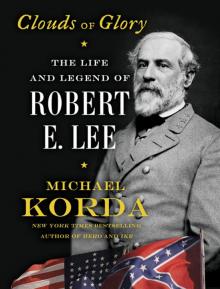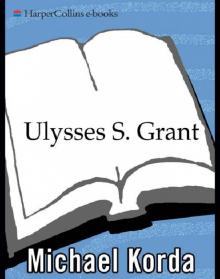- Home
- Michael Korda
Clouds of Glory Page 16
Clouds of Glory Read online
Page 16
Perhaps the only bright spot on Lee’s professional horizon was that he was named a member of the board of examiners at West Point for 1844, and during the two weeks of the cadets’ final examinations he spent a good deal of time with Major General Winfield Scott, the commanding general of the U.S. Army, who formed a good opinion of Captain Lee.
Scott was fifty-eight years old in 1844: an immense, overbearing, towering figure; formidable in appearance; already so huge in girth that he could hardly mount a horse; an authentic hero of the War of 1812; and a national presence who served in uniform under every president from Jefferson to Lincoln. Scott’s solemn dignity, his self-importance, his elaborate uniforms bedecked with every possible inch of gold lace and embroidery, his hats with flowing white plumes, his gift for what we would now call self-promotion, his impatience with minds slower than his own, his vanity, and his satisfaction in his role as the nation’s longest-surviving and apparently permanent military leader had all contributed to his unaffectionate nickname, “Old Fuss and Feathers,” but also managed to partly veil a keen intelligence, strategic skill, ruthless ambition, political shrewdness when it came to the army’s interests and his own, and an eye for talent. A Virginian with a voracious appetite for social life and a ponderous, elephantine charm, Scott was in every possible way unlike young Captain Lee, but recognized in him at once a level of competence far above the ordinary. Lee knew better than to flatter the commanding general, who absorbed flattery like a sponge but tended to despise the flatterer; he impressed Scott instead with his intelligence, his sound judgment about men, his physical presence and soldierly bearing—here was a man who looked every inch a soldier—as well as his discreet Virginian charm. That Scott was a prodigious snob is only too clear, but the downturned mouth, the thrusting jaw, and the frowning eagle eyes were easily thawed by a member of the Lee and Carter families whose father had served with honor under Washington and whose father-in-law was the master of Arlington and Washington’s adopted son. Lee may not have realized—indeed could hardly have imagined—how far his acquaintanceship with Scott would carry him, once he returned from West Point to his humdrum job of superintending New York City’s fortifications against the British, unaware that within two years he would be a national hero himself.
Between 1844 and 1846 Lee alternated between service as a kind of glorified clerk and congressional liaison at the right hand of the chief engineer in Washington, and work on the forts in New York City, with the additional honor of being “appointed as a member of the board of engineers for the Atlantic coast defenses,” which added to his responsibilities without any increase to his pay or rank. In Washington he was deluged with paperwork, and expressed his growing “horror at the sight of pen, ink and paper.” In New York he oversaw the digging of ditches and the mounting of the few guns that could be spared. It was neither interesting nor demanding work, though he amused himself by riding one of his two horses from Fort Hamilton into New York City on fair days to attend the meetings of the board of engineers, and in the winter by commuting back and forth on the large, crowded horse-drawn sleighs which served as buses, and on which his attention was drawn by the pretty girls returning from school, “held on each others laps with their bags of books and smiling faces.” He speculated to his old friend Mackay about whether one of them would sit on his lap if he offered her the opportunity, but chivalrously decided to give up his seat instead. Lee’s innocent admiration for a pretty young face was not diminished by his role as a paterfamilias.
The winter of 1845–1846 was marked by a small domestic tragedy that shook Lee badly. Just as Mary Lee was preparing to leave for Arlington, her second son, Rooney, already an “adventuresome young man” at the age of eight, climbed into the hayloft where he had been forbidden to go and cut off “the tips of two of his fingers” while playing with a chopping knife. In a piece of surgery that was advanced for the day, the two severed digits were sewn back on. Aside from the danger of infection in the days before antiseptics were in use, for some days it was doubtful whether they would “reknit,” but remarkably they did. Freeman attributes to Lee a horror of deformity, which may have increased his anxiety, and that may be so, but his daughter Anne was born with a large birthmark on her face and Lee seems to have taken it in his stride; he even wrote touchingly about it to Mary: “We must endeavor to assist her to veil if not eradicate it by the purity of and brightness of her mind.”
In any event, Lee was the most admirable and concerned of parents, sitting up every night with Rooney to make sure the boy didn’t turn over in his sleep and disturb the dressing or pull out the “ligatures.” “He may probably lose his fingers and be maimed for life. . . . You cannot conceive what I suffer at the thought,” Lee wrote, but that seems like a perfectly natural fear for any father in the circumstances. It is hardly surprising that Rooney was the subject of so many letters of advice and concern from Lee to his wife over the years about how to discipline such a wild and unbroken colt without destroying his spirit. He would describe Rooney as a boy who required a “tight rein,” but in fact Rooney and his brothers seem to have been no more than normally troublesome.
When Rooney was well enough to travel, Mary took the family home to Arlington, leaving Lee in New York to the company of the family terrier and her puppy. Early in 1846 Mary gave birth to their last child, Mildred Childe, always referred to by Lee as Milly or “Precious Life,” while Lee experienced, as he always did, the agony of being separated from his family, which spurred him to write to Mary, whose slipshod ways he dreaded, endless letters of advice on how to bring up their children, to which she seems to have paid very little attention. He was consumed by small details of construction and repair, a mistake he had made in accounting for his pay, elaborate plans to further improve and extend the fortifications of New York City, and the old worries that his salary would not allow him to provide for his children and that he had chosen the wrong career.
Events far away in Mexico were about to about to render all these concerns nugatory.
CHAPTER 4
The Perfect Warrior—Mexico, 1846–18481
War between Mexico and the United States had been simmering since the 1820s, partly as a result of political chaos in Mexico, partly as a consequence of the expanding American settlement in Texas, and partly because the largely unpopulated Mexican territory in North America, stretching from the Louisiana Purchase to California, was an open invitation to a rapidly growing and increasingly self-confident America. Americans looked westward and saw a vast and largely unmapped paradise. The phrase “manifest destiny” was not yet then in common usage, but the idea that America should stretch from the Atlantic to the Pacific Ocean was a powerful if not necessarily a popular one. It was reinforced by the fear that as a consequence of Mexico’s weakness Great Britain or Russia might seize California, and by the belief that America was and must be an exception to monarchical rule and despotism, and therefore by definition could not share the continent with other powers.
Not everybody believed it was God’s design for Americans to populate and control the continent. Americans as different as John Quincy Adams and Ulysses S. Grant were dubious about the morality of seizing so much territory from a much weaker Mexico. Even decades after the war between America and Mexico had been fought and won, Grant wrote, “Generally, the officers of the [U.S.] army were indifferent whether the annexation was consummated or not. . . . For myself, I was bitterly opposed to the measure, and to this day regard the war, which resulted, as one of the most unjust ever waged by a stronger against a weaker nation.” Many argued that America’s claim to worldwide moral authority might be diluted by such an unfair war, and of course some foresaw correctly that the question of whether slavery could be expanded into the new territories won from Mexico by conquest might upset the delicate political balance between slave and free states, and lead to civil war. Here too, Grant expressed it best, though with the wisdom of hindsight: “The Southern rebellion was largely the outgrowth of the Me
xican war. Nations, like individuals, are punished for their transgressions. We got our punishment in the most sanguinary and expensive war of modern times.” Robert E. Lee himself admitted that he would like to have been “better satisfied with the justice of our cause,” an interesting and typical understatement of his feelings.
The most immediate cause of the conflict was the presence of Americans in Tejas, which began in 1810, when Moses Austin was granted “a large tract of land” by the Mexican government—a decision that the Mexicans quickly came to regret, as increasing numbers of Americans crossed the Arkansas River and established “colonies” in the potentially rich farmland of East Texas, where they soon outnumbered native Mexicans. The “Texans,” as the Americans quickly became known, were intransigent and insatiable guests, and successive Mexican governments sought in vain to tax them, to limit their number, and to prohibit slavery. If the Mexicans had hoped that the Texans would provide a buffer between themselves and marauding bands of ferocious Comanche Indians in the north of Mexico, they were disappointed. The Texans put down roots, farmed, and brought in slaves. The mercurial General Antonio López de Santa Anna, acclaimed by his supporters as “the Napoleon of the West,” rose to power through the violent anarchy of Mexican politics and alternated between threatening the Texans and offering to sell them more land. The result was a war in which a Texan outpost was besieged and its defenders were massacred at the Alamo; this was followed by the Texans’ subsequent revenge at the Battle of San Jacinto, which forced Mexico to recognize Texan independence in 1836. Mexicans’ acceptance of the Lone Star Republic was grudging, and it soon became apparent that Mexico would regard the annexation of Texas by the United States as a casus belli; furthermore, Mexicans believed the southern border of Texas lay on the Nueces River, rather than 130 miles farther south on the Rio Grande. In 1845, when the lobbying of Texas to join the Union finally succeeded, it alarmed both the Mexicans and American northerners who opposed the expansion of slavery, and ensured that even the slightest provocation would start a war.
Provocation was not long in coming. Though Mexico had broken off diplomatic relations with the United States, President James Polk sent John Slidell as minister plenipotentiary to Mexico City to negotiate the purchase of California and New Mexico from the beleaguered Mexican government. In one year “the [Mexican] presidency changed four times, the ministry of war six times and the finance ministry sixteen times,” but if there was one subject on which all Mexicans were united it was their claim to Texas. Outraged that Slidell had not come prepared to discuss compensation for the loss of their territory, they broke off discussions, and he returned to Washington angry and empty-handed. Perhaps anticipating the Mexican reaction, President Polk had ordered Brigadier General Zachary Taylor, a Virginian and a renowned Indian fighter, to occupy the land between the Nueces River and the Rio Grande. Soon afterward a large force of Mexican cavalry attacked an American patrol, killing sixteen of the Americans in what became known as the “Thornton affair” after the patrol’s commander. This enabled Polk to inform Congress that “American blood has been shed upon American soil,” and to seek a declaration of war, which was passed despite Whig reluctance and widespread skepticism in the North.
General Taylor, who was nicknamed “Old Rough and Ready”—in deliberate contrast to General Winfield Scott’s nickname, “Old Fuss and Feathers”—for his slouching indifference to military pomp and his own unprepossessing uniform, moved quickly to defeat the Mexicans twice, at Palo Alto and the next day at Resaca de la Palma. These victories were achieved in part by vastly superior American weapons, which included quickly moved “horse artillery,” Colt’s famous “revolving pistol,” and more modern muskets than the antiquated mid-eighteenth-century weapons of the Mexicans. Nevertheless, an advance south toward Mexico City would involve a march of nearly 500 miles across harsh, difficult terrain, with sparse water, primitive roads, and almost no forage for horses—a formidable undertaking. In addition, the return to power of Santa Anna increased the likelihood that the Mexicans would fight at every opportunity in a rocky, mountainous landscape that favored the defense.
During this time, Lee remained in New York City looking after its fortifications, listening wistfully to what he described as “the Sharpening of Swords, [and] the grinding of bayonets.”* In Freeman’s words, “If he were left at Fort Hamilton he might as well reconcile himself to the certainty that he would grow old, unregarded in a corps that would assuredly give preference to the engineers who distinguished themselves in war. They would have fame; he would have slippers and old age on the porch at Arlington.” This prospect is exactly what Lee feared. The days when he could call on his former mentor and friend General Gratiot for help were long gone, and there was nobody to whom he could appeal for a combat posting; for three months he waited, saying good-bye to officers no more capable than himself who had received orders to proceed to Mexico. At last, on August 19, 1846, Lee received his own orders to proceed at once to San Antonio de Bexar in Texas (as San Antonio was then still known), and report to Brigadier General John E. Wool, whose name would eventually be given to Fort Calhoun (formerly the Rip-Raps), the man-made island that Lee had spent so much time and effort building in Hampton Roads. Lee wrote his will, collected his kit, and sailed for New Orleans on the first available steamer, not even pausing long enough to say good-bye to his family, and he was in San Antonio by September 21, just over a month after his departure from Fort Hamilton—fast traveling for the day. Much of it was hard traveling too. He wrote to Mary the moment he arrived in San Antonio: “I reached here last night, my dear Mary after a journey of six days from Port Sarassa. The first day in consequence of the intolerable heat through the prairie . . . we* could make but 12 miles where we encamped by a diminutive inlet that furnished some water enough for our horses & selves of a hot and inferior quality. I have got such a taste of prairie flies that I determined to travel by night as long as I was in this region and started the next morn[ing] before 4 a.m.”
Lee was approaching forty, still a captain, and after twenty-one years of service in the U.S. Army he had yet to hear a shot fired in anger. He was gratified to be within reach of real service at last, though his initial task was merely to round up the picks and shovels his labor force would need—not an easy task in an impoverished country where even the most basic tools were hard to come by. San Antonio was a quaint little town with a population of around 2,000, most of them Mexican, engulfed by the 3,400 American soldiers who were now encamped there. Lee visited the Alamo, still showing the damage from the twenty-day siege, and spent his brief moments off duty “bathing” in the “clear & rapid” water of the San Antonio River, to which he went either very early or late so as not to be “interrupted by the senoras or senoritas.” He admired the landscape, but found the Mexicans “an amiable but weak people . . . primitive in their habits and tastes.”
The sheer size of Mexico, coupled with the small number of American troops available, made a quick war unlikely. The distances involved alone were daunting. Brigadier General Stephen Kearny, for example, set off from Fort Leavenworth, just west of Missouri; marched all the way to Santa Fe; and from there continued on to California, over 1,500 miles. Meanwhile a cavalry detachment he sent south from New Mexico under Colonel Alexander Doniphan to Saltillo, in Mexico, made “one of the most remarkable marches in military history,” covering a total of 3,500 miles, most of it over rough desert country and despite several Apache and Comanche attacks on his column.
The Mexicans might have been expected to lose heart at the fact that a mere handful of American troops had seized and annexed both New Mexico and California without serious difficulty, but that would have underrated the strength of Mexican outrage about the loss of Texas, and the remarkable determination of Santa Anna, who understood the value in war of trading space for time. The farther American forces marched into the barren vastness of Mexico, the more thinly stretched and vulnerable their supply lines would inevitably become, hampered
as they already were by primitive or nonexistent roads, and the more possible it might be to deal them a resounding defeat before they reached Mexico City.

 Passing
Passing Another Life
Another Life Clouds of Glory
Clouds of Glory Hero: The Life and Legend of Lawrence of Arabia
Hero: The Life and Legend of Lawrence of Arabia Cat People
Cat People Hero
Hero With Wings Like Eagles: A History of the Battle of Britain
With Wings Like Eagles: A History of the Battle of Britain Ulysses S. Grant
Ulysses S. Grant